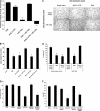Regulation of angiogenesis through a microRNA (miR-130a) that down-regulates antiangiogenic homeobox genes GAX and HOXA5
- PMID: 17957028
- PMCID: PMC2214763
- DOI: 10.1182/blood-2007-07-104133
Regulation of angiogenesis through a microRNA (miR-130a) that down-regulates antiangiogenic homeobox genes GAX and HOXA5
Abstract
Angiogenesis is critical to tumor progression. The homeobox gene GAX inhibits angiogenesis in vascular endothelial cells (ECs). We have identified a microRNA (miR-130a) that regulates GAX expression and hypothesized that it plays a major role in modulating GAX activity in ECs. A 280-bp fragment from the GAX 3'-untranslated region (3'-UTR) containing 2 miR-130a targeting sites was observed to be required for the rapid down-regulation of GAX expression by serum and proangiogenic factors, whereas the activity of the GAX promoter did not vary with exposure to serum or proangiogenic factors. This same 280-bp sequence in the GAX 3'-UTR cloned into the psiCHECK2-Luciferase vector mediated serum-induced down-regulation of the reporter gene when placed 3' of it. Finally, forced expression of miR-130a inhibits GAX expression through this specific GAX 3'-UTR sequence. A genome-wide search for other possible miR-130a binding sites revealed an miR-130a targeting site in the 3'-UTR of the antiangiogenic homeobox gene HOXA5, the expression and antiangiogenic activity of which are also inhibited by miR-130a. From these data, we conclude that miR-130a is a regulator of the angiogenic phenotype of vascular ECs largely through its ability to modulate the expression of GAX and HOXA5.
Figures







References
-
- Folkman J. Role of angiogenesis in tumor growth and metastasis. Semin Oncol. 2002;29:15–18. - PubMed
-
- Hanahan D, Folkman J. Patterns and emerging mechanisms of the angiogenic switch during tumorigenesis. Cell. 1996;86:353–364. - PubMed
-
- Bergers G, Benjamin LE. Tumorigenesis and the angiogenic switch. Nat Rev Cancer. 2003;3:401–410. - PubMed
-
- Folkman J. Angiogenesis inhibitors: a new class of drugs. Cancer Biol Ther. 2003;2:S127–S133. - PubMed
Publication types
MeSH terms
Substances
Grants and funding
LinkOut - more resources
Full Text Sources
Other Literature Sources
Molecular Biology Databases
Research Materials

